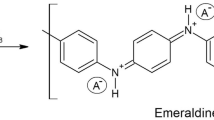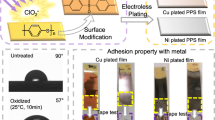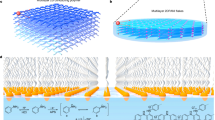Abstract
Sulfonated CPP (CPP–SO3H) was prepared by modifying chlorinated polypropylene (CPP). The results of Fourier transform infrared spectroscopy (FTIR) illustrate that the sulfonic acid group (–SO3H) was successfully grafted onto CPP. Polypropylene (PP)/CPP–SO3H/polyaniline (PANI) and PP/CPP/PANI composites were prepared, and the microstructures and electric properties of the corresponding composites were carefully investigated by scanning electron microscopy (SEM), FTIR, ultraviolet (UV)-vis and wide-angle X-ray diffraction (WAXD). Compared with that of the PP/CPP/PANI composite, the volume resistivity of the PP/CPP–SO3H/PANI composites is lower. The UV-vis results show that PANI can be doped with CPP–SO3H and that the interactional strength between PANI and CPP–SO3H increases because of the introduction of –SO3H. The results of WAXD show that CPP–SO3H is more easily inserted into the interspaces of PANI-dodecylbenzene sulfonic acid and makes the layer distance increase compared with that of CPP. The addition of CPP–SO3H can improve the crystallinity of the composites. The results of SEM show that the introduction of –SO3H on CPP is favorable for dispersion of PANI in the PP/CPP–SO3H/PANI composites, and that it results in an increase in the area of the conducting components, an improvement in conductive properties and the compatibility of the PP/CPP–SO3H/PANI composites. The above results indicate that CPP–SO3H can act as PANI's doping agent and facilitate compatibility in PP/CPP–SO3H/PANI composites.
Similar content being viewed by others
Log in or create a free account to read this content
Gain free access to this article, as well as selected content from this journal and more on nature.com
or
References
Shirakawa, H. The discovery of polyacetylene film –the dawning of an era of conducting polymers. Synthetic Met. 125, 3–10 (2001).
MacDiarmid, A. G. Synthetic metals: a novel role for organic polymers. Synthetic Met. 125, 11–22 (2001).
Heeger, A. J. Semiconducting and metallic polymers: the fourth generation of polymeric materials. Synthetic Met. 125, 23–42 (2001).
Koul, S., Chandra, R. & Dhawan, S. K. Conducting polyaniline composite: a reusable sensor material for aqueous ammonia. Sensor Actuat. B Chem. 75, 151–159 (2001).
Gerard, M., Chaubey, A. & Malhotra, B. D. Application of conducting polymers to biosensors. Biosensors Bioelectronis 17, 345–359 (2002).
Jin, Z., Su, Y. & Duan, Y. An improved optical pH sensor based on polyaniline. Sensor Actuat. B Chem. 71, 118–122 (2000).
Bernard, M. C., Hugot-Le Goff, A., Joiret, S. & Phong, P. V. Polyaniline films for protection against corrosion. Synthetic Met. 119, 283–284 (2001).
Mirmohseni, A. & Oladegaragoze, A. Anti-corrosive properties of polyaniline coating on iron. Synthetic Met. 114, 105–108 (2000).
Araujo, W. S., Margarit, I. C. P., Ferreira, M., Mattos, O. R. & Lima Neto, P. Undoped polyaniline anticorrosive properties. Electrochimica Acta. 49, 1307–1312 (2001).
MacDiarmid, A. G. Polyaniline and polypyrrole: where are we headed? Synthetic Met. 84, 27–34 (1997).
Barra, G. M. O., Leyva, M. E., Soares, B. G., Mattoso, L. H. & Sens, M. Electrically conductive, melt-processed polyaniline/EVA blends. J. Appl. Poly. Sci. 82, 114–123 (2001).
Luzny, W., Kaniowski, T. & Pron, A. Structural and transport properties of thermally processable conducting polymer: polyaniline protonated with diphenyl phosphate. Polymer 39, 475–483 (1998).
Pron, A., Luzny, W. & Laska, J. Thermally processable polyaniline protonated with diphenyl phosphate –preparation and structural aspects. Synthetic Met. 80, 191–193 (1996).
Fryczkowski, R., Slusarczyk, C. & Fabia, J. Structure and conducting properties of thermoplastic composites of polypropylene and polyaniline protonated in solid state. Synthetic Met. 156, 310–317 (2006).
Cao, Y., Smith, P. & Heeger, A. J. Counter-ion induced processibility of conducting polyaniline and of conducting polyblends of polyaniline in bulk polymers. Synthetic Met. 48, 91–97 (1992).
Laska, J., Zak, K. & Pron, A. Conducting blends of polyaniline with conventional polymers. Synthetic Met. 84, 117–118 (1997).
Laska, J., Pron, A., Zagorska, M., Lapkowski, S. & Lefrant, S. Thermally processable conducting polyaniline. Synthetic Met. 69, 113–115 (1995).
Passiniemi, P., Laakso, J., Osterholm, H. & Pohl, M. TEM and WAXS characterization of polyaniline/PP fibers. Synthetic Met. 84, 775–776 (1997).
Yang, L., Chen, J. Y. & Li, H. L. Investigation on the microstructure and the electric property of poly(propylene)/chlorinated poly(propylene)/poly(aniline) composites. J. Appl. Poly. Sci. 111, 988–997 (2009).
Yang, L., Chen, J. Y. & Li, H. L. Effects of chlorinated polypropylene on the hydrogen-bond and electric property of polypropylene/chlorinated polypropylene/polyaniline composites: FTIR analysis. Polym. Eng. Sci. 49, 462–470 (2009).
Cai, R. L., Qiu, Y., Wang, W. L., Zhang, L. C. & Hu, X. M. The research on technology and process of lining-up soluble sulphur blue through catalysis and sulphonating. Anhui Chem. Industry 34, 32–34 (2008).
Li, R. D., Ge, J. J., Zhang, G. C. & He, W. D. Study on the sulfonating conditions of alkylphenol polyxyethylene ether sulfonate synthesized by the method of Streck. J. Xi’an Shiyou University (Natural Science Edition) 25, 57–60 (2010).
Taipalus, R., Harmia, T. & Zhang, M. Q. The electrical conductivity of carbon-fibre-reinforced polypropylene/polyaniline complex-blends: experimental characterization and modeling. Compos. Sci. Technol. 61, 801–814 (2001).
Weiss, R. A., Ashish, S., Willis, C. L. & Pottick, L. A. Block copolymer ionomers: 1. Synthesis and physical properties of sulphonated poly(styrene-ethylene/butylene-styrene). Polymer 32, 1867–1874 (1991).
Wang, F. C., Feve, M., Lam, T. M. & Pascault, J. P. FTIR analysis of hydrogen bonding in amorphous linear aromatic polyurethanes. I. Influence of temperature. J. Polym. Sci. Poly. Phys. 32, 1305–1313 (1994).
Wang, F. C., Feve, M., Lam, T. M. & Pascault, J. P. FTIR analysis of hydrogen bonding in amorphous linear aromatic polyurethanes. II. Influence of styrene solvent. J. Polym. Sci. Poly. Phys. 32, 1315–1320 (1994).
Ren, B., Huang, H., Liu, S. Q. & Yu, H. Z. Spectra analysis of PAn/PVA conductive composites. Chinese J. Spectrosc. Lab. 20, 165–168 (2003).
Potje-Kamloth, K., Polk, B. J., Josowicz, M. & Janata, J. Doping of polyaniline in the solid state with photogenerated triflic acid. Chem. Mater. 14, 2782–2787 (2002).
Levon, K., Ho, K. H., Zheng, W. Y., Laakso, J., Taka, T. & Osterholm, J. E. Thermal doping of polyaniline with dodecylbenzene sulfonic acid without auxiliary solvents. Polymer 36, 2733–2738 (1995).
Pan, W., Yang, S. L., Li, G. & Jiang, J. M. Electrical and structural analysis of conductive polyaniline/polyacrylonitrile composites. Eur. Polym. J. 41, 2127–2133 (2005).
Obadal, M., Cermak, R. & Stoklasa, K. Tailoring of three-phase crystalline systems in isotactic poly(propylene). Macromol. Rapid. Comm. 26, 1253–1257 (2005).
Acknowledgements
This paper is based on the results from the subject supported by the National Basic Research Program of China (2005CB623800).
Author information
Authors and Affiliations
Corresponding author
Ethics declarations
Competing interests
The authors declare no conflict of interest.
Rights and permissions
About this article
Cite this article
Yang, L., Zhang, Z., Wang, X. et al. Sulfonation of chlorinated polypropylene and its influence on the microstructure and the electric properties of polypropylene/chlorinated polypropylene/polyaniline composites. Polym J 44, 388–395 (2012). https://doi.org/10.1038/pj.2011.139
Received:
Revised:
Accepted:
Published:
Issue date:
DOI: https://doi.org/10.1038/pj.2011.139



